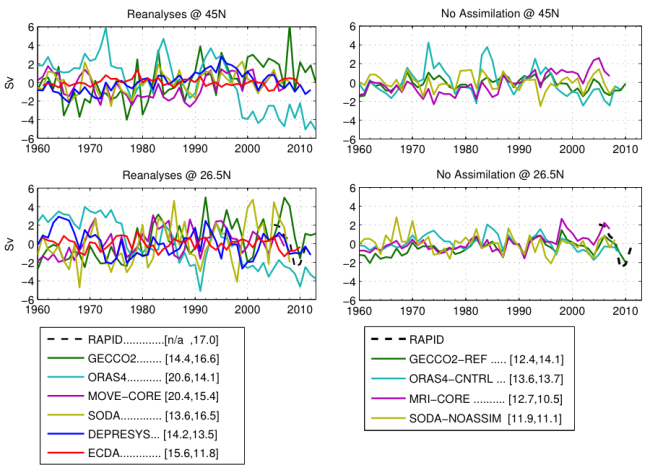Historical record of AMOC variability inconsistent in ocean reanalysis products
While the circulation of the Atlantic Ocean has a complex three-dimensional spatial structure, the zonally integrated flow in the basin, referred to as the Atlantic Meridional Overturning Circulation (AMOC), is largely responsible for the net northward oceanic heat transport on climate-relevant timescales. This makes the AMOC a key metric for quantifying the mean state of the ocean and its historical change. Karspeck et al. (2015) examines the mean and variability of the AMOC as represented in six ocean reanalysis products over the period 1960-2007, with particular focus on multi-decadal trends and interannual variability at 26.5°N and 45°N. Ocean reanalysis products, developed independently at modeling centers around the world, use historical surface observations and subsurface ocean hydrography to constrain the solution of ocean general circulation models. They represent an estimate of the spatially and temporally complete state of the global ocean given the sparse network of historical ocean observations.

One of the key findings of this work is that, contrary to the conventional expectation that the imposition of subsurface data constraints will draw the AMOC in reanalysis products into agreement, the historical AMOC variability is less consistent among the reanalysis products than in corresponding simulations without subsurface data constraints. This finding has implications for how the scientific community understands the implicit uncertainties in the current generation reanalysis products.
Comparison of the Atlantic Meridional Overturning Circulation between 1960 and 2007 in six ocean reanalysis products (Climate Dynamics)
1 National Center for Atmospheric Research
2 University of Hamburg, DE
3 European Centre for Medium-range Weather Forecasts, UK
4 Met Office Hadley Centre, UK
5 Meteorological Research Institute, Japan Meteorological Agency, Japan
6 Geophysical Fluid Dynamics Laboratory, NOAA
7 Texas A&M University
Topics
- AMOC
